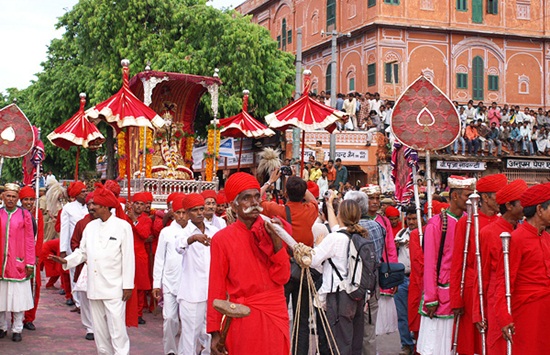Teej Festival is as important an occasion as Karva Chauth for the womenfolk of Rajasthan. This regional festivity is a celebration of Goddess Parvati’s reunion with Lord Shiva and a tradition for women to pray for the wellbeing of their husbands. The religious significance and the social implication of Teej Festival are fused in the celebration. According to the locals, the festivity also marks the arrival of rains in the desert of Rajasthan. So, it symbolizes the bliss of rejuvenation in aridity.
Worshipping Goddess Parvati and seeking her blessings for marital happiness is the core of Teej Festival. According to the Hindu philosophy, the universe is a manifestation of the Supreme Power or Adi Shakti in a feminine form that refers to Goddess Parvati. She endows with power and devotion that women need for marital felicity. Like other festivals of Rajasthan, the worship of the Goddess entails a series of rituals.
Teej is a three-day long festivity. The first day is known as Sinjahara; Teej is the second day; Badi Teej is the third day. Sinjahara is marked by the Mehendi ritual among the married women and the would-be married girls. They customarily beautify their hands with Mehendi designs and receive gifts from their in-laws. The gifts mainly include lehariya saree, bangles, jewelry, Mehendi, sindoor (vermillion), makeup items and some sweets. The in-laws also receive gifts from the parents of their daughters-in-law.
It is a tradition for the married women to celebrate the festival at their parents’ homes. Fasting in honor of Goddess Parvati and for the longevity of husbands or would-be husbands is the most important custom to be performed on the second day of the festival. Women keep rigorous fasting the whole day. Another rigorous ritual is to keep an oil lamp lit all night. If the lamp is extinguished or blown out, it is anticipated as a premonition.
A procession with the adorned idol of Goddess Parvati is another important ceremony of the Teej Festival celebration in Jaipur. The idols of the goddess are dressed in colorful clothes and adorned with jewelry. The procession on the streets makes a spectacular show. It is accompanied by folk dance forms and songs.
The glittering procession from the City Palace has become a tourist attraction of Jaipur. The life-size idol of the goddess is placed in a gold and silver palanquin which the royal guards of the City Palace carry ahead of folk dancers, ornamented camels, embellished elephants and bedecked horses. Kacchi ghodi, kalbeliya, algoza, bahrupia, and chakri dance are some of the folk dance performances adding to the attraction of the procession.
The main celebration (second day) of Teej Festival is scheduled on July 30 this year. Many NRIs in the Marwari community fly to India on this occasion and celebrate the festivity with the native folks. Most of them book online cheap flights to Rajasthan and other states of India.
If you have not yet booked your trip to India for Teej Festival, log on to IndianEagle.com and get the cheapest airfare.










